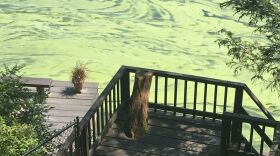Lake George has had its first confirmed discovery of Harmful Algal Blooms. As WAMC’s Southern Adirondack Bureau Chief Lucas Willard reports, advocates say the time to act is now to prevent spread.
Harmful Algal Blooms occur when algae, simple plant-like organisms, grow out of control. HABs can release toxins into the water, harming wildlife and humans alike.
And Lake George, known for its crystal clear waters, has until now avoided such events.
Recently, trained spotters with the Lake George Association discovered a bloom in the southern portion of the lake, in an area known as Harris Bay. The find was confirmed by state environmental officials – it is the first HAB found in the Queen of American Lakes.
Walt Lender is executive director of the LGA.
“Lake George has always been and is a low-nutrient lake. So we typically would not expect to see a harmful algal bloom, however, this clearly shows us that we are not immune to harmful algal blooms,” said Lender.
LGA staff are now searching for other HABs on the lake.
According to the state Department of Environmental Conservation, which confirmed the bloom in Harris Bay on Monday, the HAB dissipated but may re-form in a recent warm stretch of weather.
The cyanobacteria species detected in the Harris Bay bloom is a species that is commonly found in New York HABs, according to DEC.
As monitoring continues, the discovery allows for technology to take a role.
The Jefferson Project, a collaboration between IBM Research, RPI, and the FUND for Lake George, has extensively mapped the lake and continues to collect a variety of data – water temperature, wind speed, nutrients, etc.
Eric Siy, Executive Director of the FUND For Lake George, says a similar kind of study was conducted on Skaneateles Lake, an Onondaga County lake that had its first HAB in 2017. He said technology was able to find what contributed to the bloom there.
“What we found is that it’s a combination of factors. From wind to currents in the water, to upwelling of nutrients from the bottom. So it’s this perfect storm of factors that results in a HAB. But, again, it needs to be stressed: there is no one prescription for a HAB event,” said Siy.
For years, advocates for Lake George have sought the assistance from municipalities and homeowners surrounding the lake in doing their part to mitigate stormwater runoff, keep septic systems in working order, and take other steps to prevent nutrients that feed algae from entering the lake.
Walt Lender says now is a time for action.
“Everyone needs to take a very close look at their property. The municipalities that we work with need to help out some more. I mean they’ve been very cooperative, but I think there’s an opportunity here to put in more stormwater retrofits and put in more dry-wells and other stormwater management devices to stop this stormwater from entering the lake and bring nutrients into the lake,” said Lender.








